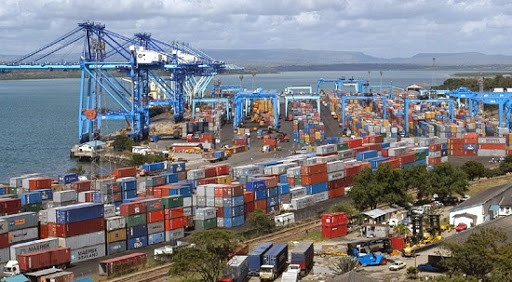The port of Mombasa has lately witnessed major improvement through multi-billion infrastructural and technology investment.
The ongoing expansion programme including the construction of the Ksh. 32 billion phase two of the second container terminal are part of the measures to transform the port into a logistics hub in the region.
Phase one of the second container terminal built at a cost of Ksh. 26 billion which involved reclaiming of a sea area of about 50 acres creating 550,000 Twenty-Foot Equavalent Unit (TEUs) capacity was commissioned in 2016.
A key national government technical committee in charge of implementation of projects and programmes visited the port on Thursday to inspect its facilities and operations.
The National Development Implementation Technical Committee (NDITC) led by its Chairman Karanja Kibicho expressed satisfaction on the positive developments and measures to make the port more efficient and competitive.
Dr Kibicho who is also the Principal Secretary for Interior and Coordination of National Government called on all the players to strive to improve efficiency and reduce cost of doing business to make the port one of the best globally.
He was accompanied by Principal Secretaries Julius Muia (National Treausry), Johnson Weru Mwangi (Trade), Nancy Karigithu (Shipping and Maritime) and Kenya Ports Authority (KPA) Acting Managing Director Rashid Salim.
Others were Chairman of Industrial and Commercial Development Corporation (ICDC) John Ngum, KPA Chairman Gen (Rtd) Joseph Kibwana, Commissioner General Kenya Revenue Authority (KRA) Githii Mburu, Chief Executive Officer (CEO) Kenya Association of Manufacturers Phyllis Wakiaga and Coast Regional Commissioner John Elungata.
Among the areas visited by the committee were Berths 14, 16 and 21, Standard Gauge Railway (SGR) Marshaling Yard and Scanners at Port Reitz.
“The overall objective is to make the port of Mombasa a classic facility, achieve high productivity and guarantee efficient cargo freight services to importers and exporters,” said Dr Kibicho.
He attributed the good performance to proper coordination among state agencies and other maritime stakeholders.
“The purpose of our visit is to familiarize ourselves with port operations and challenges with the view of enhancing efficiency,” added Dr Kibicho.
The Port of Mombasa remains among the top 120 world container ports and among the top six in Africa. It is connected to over 80 ports globally and served by over 40 shipping lines.
KPA has undertaken expansion and modernization process to ensure the port of Mombasa remains one of the best equipped in the region.
The new equipment is part of the massive infrastructural investments and modernization of cargo handling facilities being undertaken by KPA to enhance efficiency at the port.
The port has also witnessed steady growth in import volumes for both general and containerized cargo following the cessation of Covid-19 restrictions and lock-downs from the major import countries.
According to the Kenya Port Authority (KPA) Acting Managing Director Eng. Rashid Salim, the port’s performance in February 2021 surpassed that of a similar period in 2020 and 2019.
The port handled over 115,000 TEU’s against 108,000 TEU’s handled in 2020 while for non-containerized cargo it handled 1 million tons against 800,000 tons recorded in 2020 which represented an increase by 20 percent.
The acting MD attributed the improved performance to measures currently being undertaken by KPA working alongside shipping lines and other port stakeholders to streamline operations.
Recently, KPA took over the loading and offloading of SGR operations at Port Reitz Yard and reorganized all rail operational processes with logistic partners hence increasing end to end efficiency in the rail evacuation.
In January, the port registered the highest SGR performance with 241 trains clearing 24,256 TEU’s, the highest in a single month since its inception.
Eng. Salim said evacuation of cargo by rail has significantly contributed to the speedy import container deliveries with a daily average of 1000 TEU’s ferried by 10-11 trains from the Port of Mombasa to the Inland Container Depot Nairobi.
He added that this is a remarkable improvement in performance as compared to the period running from mid-December 2020 to early January 2021 when the port experienced vessel build up leading to cargo backlog.

